Cite this document
(“Identities in Conflict around the Mediterranean Sea: the Unsolved Admission/Application Essay”, n.d.)
Identities in Conflict around the Mediterranean Sea: the Unsolved Admission/Application Essay. Retrieved from https://studentshare.org/business/1483256-identities-in-conflict-around-the-mediterranean
Identities in Conflict around the Mediterranean Sea: the Unsolved Admission/Application Essay. Retrieved from https://studentshare.org/business/1483256-identities-in-conflict-around-the-mediterranean
(Identities in Conflict Around the Mediterranean Sea: The Unsolved Admission/Application Essay)
Identities in Conflict Around the Mediterranean Sea: The Unsolved Admission/Application Essay. https://studentshare.org/business/1483256-identities-in-conflict-around-the-mediterranean.
Identities in Conflict Around the Mediterranean Sea: The Unsolved Admission/Application Essay. https://studentshare.org/business/1483256-identities-in-conflict-around-the-mediterranean.
“Identities in Conflict Around the Mediterranean Sea: The Unsolved Admission/Application Essay”, n.d. https://studentshare.org/business/1483256-identities-in-conflict-around-the-mediterranean.


